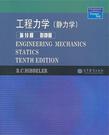工程力学
2004-1
北京蓝色畅想图书发行有限公司(原高等教育出版社)
希伯勒
无
《工程力学:静力学(第10版)(影印版)》是典型的美式教材,它具有以下一些特点:基本概念、基本原理的叙述简明、准确、便于掌握,
强调理论应用,配有大量例题和习题,多来自实际问题,有利于应用理论解决实际问题能力的培养,关注学习方法的指导,详尽介绍各类问题的解决思路、方法、技巧,便于自学。
作者:(美国)希伯勒(Hibbeler R.C.)
1 General Principles
Chapter Objectives
1.1 Mechanics
1.2 Fundamental Concepts
1.3 Units of Measurement
1.4 The International System of Units
1.5 Numerical Calculations
2 Force Vectors
Chapter Objectives
2.1 Scalars and Vectors
2.2 Vector Operations
2.3 Vector Addition of Forces
2.4 Addition of a System of Coplanar Forces
2.5 Cartesian Vectors
2.6 Addition and Subtraction of Cartesian Vectors
2.7 Position Vectors
2.8 Force Vector Directed Along a Line
2.9 Dot Product
3 [ Equilibrium of a ParticleChapter Objectives
3.1 Condition for the Equilibrium of a Particle
3.2 The Free-Body Diagram
3.3 Coplanar Force Systems
3.4 Three-Dimensional Force Systems
4 Force System Resultants
Chapter Objectives
4.1 Moment of a Force--Scalar Formulation
4.2 Cross Product
4.3 Moment of a Force--Vector Formulation
4.4 Principle of Moments
4.5 Moment of a Force About a Specified Axis
4.6 Moment of a Couple
4.7 Equivalent System
4.8 Resultants of a Force and Couple System
4.9 Further Reduction of a Force and Couple System
4.10 Reduction of a Simple Distributed Loading
5 Equilibrium of a Rigid Body
Chapter Objectives
5.1 Conditions for Rigid-Body Equilibrium
5.1 Equilibrium in Two Dimensions
5.2 Free-Body Diagrams
5.3 Equations of Equilibrium
5.4 Two- and Three-Force Members
5.4 Equilibrium in Three Dimensions
5.5 Free-Body Diagrams
5.6 Equations of Equilibrium
5.7 Constraints for a Rigid Body
6 Structural Analysis
Chapter Objectives
6.1 Simple Trusses
6.2 The Method of Joints
6.3 Zero-Force Members
6.4 The Method of Sections
6.5 Space Trusses
6.6 Frames and Machines
7 Internal Forces
Chapter Objectives
7.1 Internal Forces Developed in Structural Members
7.2 Shear and Moment Equations and Diagrams
7.3 Relations Between Distributed Load,Shear, and Moment
7.4 Cables
8 Friction
Chapter Objectives
8.1 Characteristics of Dry Friction
8.2 Problems Involving Dry Friction
8.3 Wedges
8.4 Frictional Forces on Screws
8.5 Frictional Forces on Flat Belts
8.6 Frictional Forces on Collar Bearings, Pivot Bearings, and
Disks
8.7 Frictional Forces on Journal Bearings
8.8 Rolling Resistance
9 Center of Gravity and Centroid
Chapter Objectives
9.1 Center of Gravity and Center of Mass for a System of
Particles
9.2 Center of Gravity, Center of Mass and Centroid for a
Body
9.3 Composite Bodies
9.4 Theorems of Pappus and Guldinus
9.5 Resultant of a General Distributed Loading
9.6 Fluid Pressure
10 Moments of Inertia
Chapter Objectives
10.1 Definition of Moments of Inertia for Areas
10.2 Parallel-Axis Theorem for an Area
10.3 Radius of Gyration of an Area
10.4 Moments of Inertia for an Area by Integration
10.5 Moments of Inertia for Composite Areas
10.6 Product of Inertia for an Area
10.7 Moments of Inertia for an Area About Inclined Axes
10.8 Mohr's Circle for Moments of Inertia
10.9 Mass Moment of Inertia
11 Virtual Work
Chapter Objectives
11.1 Definition of Work and Virtual Work
11.2 Principle of Virtual Work for a Particle and a Rigid
Body
11.3 Principle of Virtual Work for a System of Connected Rigid
Bodies
11.4 Conservative Forces
11.5 Potential Energy
11.6 Potential-Energy Criterion for Equilibrium
11.7 Stability of Equilibrium
Appendices
A. Mathematical Expressions
B. Numerical and Computer Analysis
C. Review for the Fundamentals of Engineering Examination
Answers to Selected Problems
Index
版权页: 插图: Mechanics can be defined as that branch of the physical sciences concerned with the state of rest or motion of bodies that are subiected to the action of forces.In general,this subject is subdivided into three branches:rigid-body mechanics,deformable-body mechanics,and fluid mechanics.This book treats only rigid-body mechanics since it forms a suitable basis for the design and analysis of many types of structural,mechanical,or electrical devices encountered in engineering.Also.rigid-body mechanics provides part of the necessary background for the studyof the mechanics of deformable bodies and the mechanics of fluids. Rigid-body mechanics is divided into two areas:statics and dynamics.Statics deals with the equilibrium of bodies,that is, those that are either at rest or move with a constant velocity;whereas dynamics is concerned with the accelerated motion of bodies,Although statics can be considered as a special case of dynamics,in which the acceleration is zero,statics deserves separate treatment in engineering education since many objects are designed with the intention that they remain in quilibrium.Historical Development. The subject of statics developed very early in history because the principles involved could be formulated simply from measurements of geometry and force. For example, the writings of Archimedes (287-212 B.C.) deal with the principle of the lever. Studies of the pulley, inclined plane, and wrench are also recorded in ancientwritings--at times when the requirements of engineering were limited primarily to building construction. Since the principles of dynamics depend on an accurate measurement of time, this subject developed much later. Galileo Galilei (1564-1642)was one of the first major contributors to this field. His work consisted of experiments using pendulums and falling bodies. The most significant contributions in dynamics, however, were made by Issac Newton (1642-1727), who is noted for his formulation of the three fundamental laws of motion and the law of universal gravitational attraction. Shortly after these laws were postulated, important techniques for their application were developed by Euler, D'Alembert, Lagrange, and others.

无
双语工程力学必备书
看完了,觉得内容超好,可惜有些内容用不到(与专业关系不大的那些内容)。
老顾客了,还是一如既往的好,好评!
给孩子买的,书的质量和印刷质量都很好